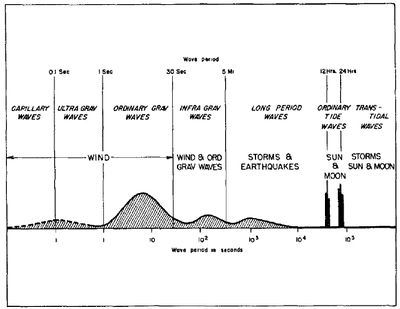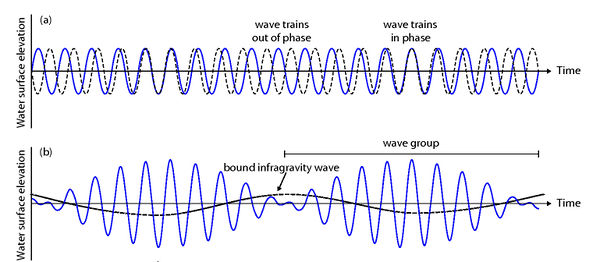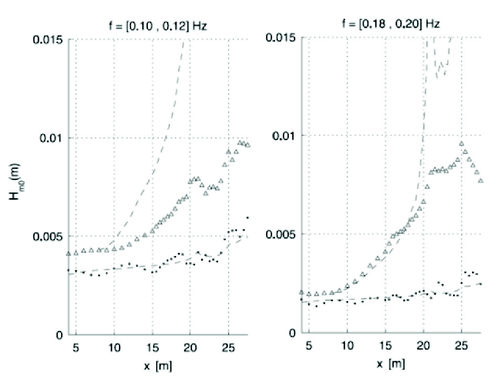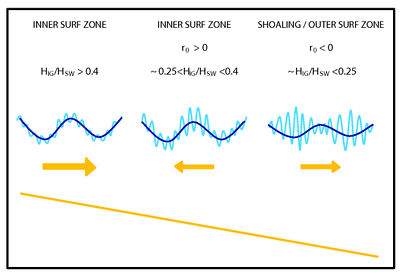Difference between revisions of "Infragravity waves"
Dronkers J (talk | contribs) |
Dronkers J (talk | contribs) |
||
| Line 80: | Line 80: | ||
|AuthorName= De Bakker, A.}} | |AuthorName= De Bakker, A.}} | ||
| − | [[Category: | + | [[Category:Physical coastal and marine processes]] |
| − | [[Category: | + | [[Category:Beaches]] |
| − | [[Category: | + | [[Category:Hydrodynamics]] |
| − | + | [[Category:Morphodynamics]] | |
| − | [[Category: | ||
Revision as of 21:08, 28 June 2019
Contents
Introduction

Infragravity waves are ocean surface waves with a typical period of 25-250s (frequency of 0.004-0.04 Hz, see Fig. 1). They are indirectly formed by the wind because they receive their energy from the short sea- and swell waves, which have typical periods of 2-20s. While infragravity waves are generally small on the open ocean, close to the coast they can be up to a few meters in height and thus dominate the water motion, in particular during storms. Since their first observations their presence has been observed to influence many nearshore processes [2] [3] varying from coastal erosion during storms, to coral reef hydrodynamics and the generation of seiche in harbors. Their generation and transformation while travelling towards the coast will be described in more detail below, together with a brief description of their noted influence in various coastal environments.
Generation
Infragravity waves are indirectly formed by the wind. Their creation is linked to the presence of short-wave groups, which are formed due to the superposition of two different short-wave trains, with wave lengths and frequencies that are very similar. When the waves are in phase their amplitudes are added, and when they are out of phase their amplitudes damp each other out (Fig. 2a). This results in a wave group structure (Fig. 2b), which is irregular in shape due to the various frequencies present in a natural wave field. The first mechanism that can form infragravity waves is due to the fact that the larger short waves in the short-wave group transport more momentum than the smaller waves, leading to a water level lowering under the larger waves, and a relative water level increase under the smaller waves. This induces a variation of the mean water level on a group scale, and results in energy that fluctuates at the same frequency as the wave group. This induced wave is bound to the group, and is 180 degrees out of phase. On the open sea/ocean these bound infragravity waves are only about a centimeter in height. [4]

The second mechanism in which infragravity waves are formed is related to the varying breakpoint of the short-wave group in shallow water. [6] The largest short waves in the group will break slightly further offshore than the smallest waves in the group. This forces a time-variation of the radiation stress in the surf zone, which is balanced by a time-varying wave setup, and creates energy at infragravity frequencies. Battjes et al. [7] suggested that the importance of the two above mentioned mechanisms varies with beach slope. The bound wave mechanism is strongest on gently sloping beaches whereas the breakpoint mechanism dominates on steep beaches.
Propagation

The bound infragravity wave generated on the open ocean grows slowly but steadily while travelling into shallower water. In addition to conservative shoaling they grow due to a continuous nonlinear energy receival from the short waves. In shallow water, when the energy transfers strengthen due to near-resonance, the infragravity wave grows in height more rapidly. The maximum height that the infragravity wave can obtain depends on the bed slope, as during the longer propagation time in shallow water on a gentle slope, more energy can be transferred than on a steep slope. [8] The growth rate of infragravity waves varies depending on the typical frequency, from the free-wave variation [math]h^{-1/4}[/math] (Greens law, [math]h[/math] is water depth) for the lower frequencies, to nearly the shallow water limit of the equilibrium solution [math]h^{-5/2}[/math] (LHS62 asymptote [9]) for the higher frequencies, see also Fig. 3. In the surf zone, where the short waves are breaking, the group structure disappears, and the infragravity waves propagate ashore as free waves. [9][10][11]
Edge waves
Infragravity waves that arrive at the coast are generally reflected off the beach and, depending on bathymetry and angle of propagation, can travel back into the open sea as leaky waves or become trapped to the coast as edge waves. Edge waves remain close to the coast by repetitive refraction over a sloping bathymetry followed by reflection off the beach. Edge waves are standing in the cross-shore direction and are progressive alongshore, with their maximum amplitude at the shoreline. Their shapes are characterised by edge modal numbers [math]n[/math], that correspond to the number of zero-crossings in the cross-shore before being refracted. Mode 0 is the most common and has the smallest alongshore wave length. The largest part of reflected infragravity waves on gently sloping beaches is assumed to become an edge wave. [12] Approximately shorenormal waves result in an equal distribution of infragravity edge waves along the coast, but with obliquely incident waves and the breaking-induced alongshore current an asymmetric distribution in dominant propagation direction is created. The presence of a sandbar may cause infragravity waves to become trapped on the bar, refracting from one side to the other side of the bar. [13]
Dissipation
During the decades after their first observations it was assumed that, contrary to the short waves that break and dissipate their energy close to shore, infragravity waves reflect off the beach face and conserve their energy completely due to their low steepness (long wave length and relatively low wave height). Nowadays, it is well established that close to the shoreline infragravity waves can lose a substantial part of their energy too [14][15][16], in particular on gently sloping beaches and for the highest infragravity 65 frequencies. Infragravity waves are assumed to dissipate their energy either by transferring their energy back to higher frequencies. [16][17][18] , or by infragravity-wave breaking [19][20] A third mechanism, bottom friction, is only of secondary importance on sandy beaches but is highly relevant on coral reefs, where the friction factor is an order of magnitude larger. [21][22] The relative importance of the first two mechanisms depends on the beach slope. On gently sloping beaches where infragravity waves are relatively large compared to short waves, infragravity waves generate higher harmonics and steepen up, leading to breaking and associated large energy losses close to the shoreline. On the contrary, on steep sloping beaches infragravity waves are relatively small and interact with the short-wave spectral peak during energy loss. Energy is spread to a large range of higher (short-wave) frequencies, but overall less energy is removed from the infragravity band than on more gentle slopes.
Various coastal environments
Beaches
Hydrodynamics
The hydrodynamics close to the coast are affected by infragravity waves in various ways. Infragravity waves contribute to the run-up on (especially gently sloping) beaches [23][24][25][26] and coral reefs. [27] This larger run-up can lead to more overwash and flooding, and can therefore contribute considerably to beach- and dune- erosion. [28]. Many empirical relations have been proposed to relate incident wave conditions to the maximum (infragravity) runup, suggesting proportionality to [math](H_{s0}/L_0)^{1/2}[/math], where [math]H_{s0}[/math] and [math]L_0[/math] are the offshore short waveheight and wave length, respectively. [29] More accurate run-up predictions require taking the directional spread and frequency spread of the wave field into account. [30]
Observations show that infragravity motions influence the temporal behavior of rip currents [31], stimulating the detaching of eddies from the rip currents and thereby affecting the mixing in the cross- and alongshore. [32]. Infragravity waves also induce fluctuations in the groundwater by bottom pressure variations, in particular in the saturated swash zone on sandy, gently sloping beaches with an infragravity- dominated swash zone. [33][34]
Sand transport

Sand suspension and transport by infragravity waves has been investigated by many research groups. The observed suspension mechanisms, transport magnitudes and directions vary substantially between these studies, which seems to be linked to the different ratio of infragravity-wave height with respect to the short-wave height [math]H_{IG}/H_{SW}[/math] during the various studies (Fig. 4). When the infragravity wave height is relatively small (generally true for somewhat steeper beaches), sand is suspended by the short waves on infragravity time-scale. When the infragravity wave is still bound, the largest short waves are at the trough of the infragravity wave (negative correlation [math]r_0 [/math]between the short-wave group and the infragravity wave at zero lag). Because most sand is stirred here, bound infragravity waves transport sand seaward. In the inner part of the surf zone, when the infragravity wave is free, the largest short waves are present at the crest of the infragravity wave (the water depth is locally increased here; short waves can prevail a little longer and correlation [math]r_0 \gt 0 [/math]), and sand transport is mostly shoreward directed by the onshore infragravity velocities. Overall, this transport is only a small fraction of the total cross-shore transport. When the infragravity-wave height is relatively large compared to short-wave height (generally true in the inner surf zone on gently sloping beaches), infragravity waves can stir sand up from the bed themselves as well, and sand is suspended under the offshore directed infragravity wave velocities. This process is most likely enhanced by an interplay with the undertow. For these conditions, infragravity-wave transport can contribute considerably to the cross-shore transport, especially during storms when the infragravity wave is most energetic.
Tidal inlets
At wave-dominated shallow tidal inlets (mean water depth and tidal amplitude of the same order), observations and model simulations show that velocities associated with infragravity frequencies can be of the same order of magnitude, or even larger, than tidal currents. [36] [37] As infragravity-wave energy is blocked during ebb, due to the opposing tidal currents, infragravity waves propagate only into the inlet and lagoon during rising tide. This could promote a flood dominance, and contribute to a possible closure of shallow inlets during winter storms. [36]
Coral reef environments
As short-waves dissipate their energy strongly while travelling over the reef flat, the longer infragravity waves can dominate the water motion more and more further away from the reef edge. [22][38] Infragravity waves are usually progressive over wide reefs with relatively shallow water depths and high roughness values, whereas they can be reflected and resonant on smooth reefs and for certain combinations of water depth and reef width. [39][40]
Seiche in harbors
Resonance of infragravity waves in semi-enclosed basins such as inlets and harbors can seriously affect harbor operations and cause damage to for example moored ships. [41][42] Resonance occurs when the period of the incident long waves is close to the natural oscillation periods of the basin. It causes standing waves to form within the basin with strong vertical water oscillations at the antinodes, and strong horizontal currents at the nodes. Small harbors in particular (1 km[math]^2[/math] and a waterdepth of about 5-10 m) have modes close to the infragravity periods, and are therefore prone to seiche induced by these waves. [43] Seiches occurring in larger harbor basins are primarily caused by subtidal wave motions at periods longer than the infragravity periods; these wave motions (from several minutes up to about 1 hour) are thought to be related to atmospheric pressure fluctuations during storms or to internal wave motions in the ocean.[44][45]
Other
In addition, infragravity waves can contribute to the seismic movement of coastal cliffs [46], and are related to the occurrence of microseisms with periods between 30-300 s, also called the Earth’s hum. [47][48] Furthermore, it is suggested that infragravity frequencies also play an important role in ice-shelf collapse. [49]
References
- ↑ Munk, W., 1950. Origin and generation of waves, in: Proceedings of First Conference on Coastal Engineering, Long Beach, California
- ↑ Munk, W., 1949. Surf beat, in: Eos Trans. AGU, 30, 849-854
- ↑ Tucker, M., 1950. Surfbeats: Sea waves of 1 to 5 minutes period., in: Proc. R.Soc. London A278 202-565-573
- ↑ Aucan, J., Ardhuin, F., 2013. Infragravity waves in the deep ocean: An upward revision. Geophysical Research Letters 40, 3435–3439
- ↑ OpenUniversity, 1994. Waves, Tides and Shallow-water Processes. Pergamon Press, Oxford
- ↑ Symonds, G., Huntley, D., Bowen, A.J., 1982. Two-dimensional surf beat: Long wave generation by a time-varying breakpoint. Journal of Geophysical Research 87, 492–498
- ↑ 7.0 7.1 Battjes, J.A., Bakkenes, H.J., Janssen, T.T., van Dongeren, A.R., 2004. Shoaling of subharmonic gravity waves. Journal of Geophysical Research 109. C02009, doi:10.1029/2003JC001863
- ↑ De Bakker, A.T.M., Tissier, M.F.S., Ruessink, B.G., 2015. Beach steepness effects on nonlinear infragravity-wave interactions: a numerical study. Journal of Geophysical Research 121, doi:10.1002/2015JC011268
- ↑ 9.0 9.1 Longuet-Higgins, M.S., Stewart, R.W., 1962. Radiation stress and mass transport in gravity waves, with application to ’surf beats’. Journal of Fluid Mechanics 13, 481–504
- ↑ Herbers, T.H.C., Elgar, S., Guza, R.T., 1995. Generation and propagation of infragravity waves. Journal of Geophysical Research 100, 24863–24872
- ↑ Ruessink, B.G., 1998. Bound and free infragravity waves in the nearshore zone under breaking and nonbreaking conditions. Journal of Geophysical Research 103, 12.795–12.805
- ↑ Herbers, T.H.C., Elgar, S., Guza, R.T., O’Reilly, W.C., 1995b. Infragravity-frequency (0.005-0.05 hz) motions on the shelf. part ii: Free waves. Journal of Physical Oceanography 25, 1063–1079
- ↑ Bryan, K., Howd, P., Bowen, A., 1998. Field observations of bar-trapped edge waves. Journal of Geophysical Research: Oceans 103, 1285–1305
- ↑ Ruessink, B.G., 1998b. The temporal and spatial variability of infragravity energy in a barred nearshore zone. Continental Shelf Research 18, 585–605
- ↑ Sheremet, A., Guza, R.T., Elgar, S., Herbers, T.H.C., 2002. Observations of nearshore infragravity waves: Seaward and shoreward propagating components. Journal of Geophysical Research 107. C8
- ↑ 16.0 16.1 Henderson, S.M., Guza, R.T., Elgar, S., Herbers, T.H.C., Bowen, A.J., 2006. Nonlinear generation and loss of infragravity wave energy. Journal of Geophysical Research 111, C12007
- ↑ Thomson, J., Elgar, S., Raubenheimer, B., Herbers, T.H.C., Guza, R.T., 2006. Tidal modulation of infragravity waves via nonlinear energy losses in the surfzone. Geophysical Research Letters 33. L05601
- ↑ Ruju, A., Lara, J.L., Losada, I.J., 2012. Radiation stress and low-frequency energy balance within the surf zone: A numerical approach. Coastal Engineering 68, 44–55
- ↑ Van Dongeren, A., Battjes, J., Janssen, T., van Noorloos, J., Steenhauer, K., Steenbergen, G., Reniers, A., 2007. Shoaling and shoreline dissipation of low-frequency waves. Journal of Geophysical Research 112. C02011
- ↑ De Bakker, A.T.M., Herbers, T.H.C., Smit, P.B., Tissier, M.F.S., Ruessink, B.G., 2015. Nonlinear infragravity-wave interactions on a gently sloping laboratory beach. Journal of Physical Oceanography 45, 589–605, doi: 10.1175/JPO–D–14–0186.1
- ↑ Pomeroy, A., Lowe, R., Symonds, G., Van Dongeren, A., Moore, C., 2012. The dynamics of infragravity wave transformation over a fringing reef. Journal of Geophyiscal Research 117
- ↑ 22.0 22.1 Van Dongeren, A.R., Lowe, R., Pomeroy, A., Trang, D., Roelvink, D., Symonds, G., Ranasinghe, R., 2013. Numerical modeling of low-frequency wave dynamics over a fringing coral reef. Coastal Engineering 73, 178–190, doi: 10.1016/j.coastaleng.2012.11.004
- ↑ Guza, R.T., Thornton, E.B., Holman, R.A., 1984. Swash on steep and shallow beaches, in: Proceedings of the 19th International Conference on Coastal Engineering, ASCE, 708-723
- ↑ Holman, R.A., Sallenger, A.H., 1985. Setup and swash on a natural beach. Journal of Geophysical Research 90, 945–953
- ↑ Ruessink, B.G., Houwman, K.T., Hoekstra, P., 1998. The systematic contribution of transporting mechanisms to the cross-shore sediment transport in water depths of 3 to 9 m. Marine Geology 152, 295–324
- ↑ Ruggiero, P., Holman, R.A., Beach, R.A., 2004. Wave run-up on a high-energy dissipative beach. Journal of Geophysical Research 109, C06025, doi:10.1029/2003JC002160
- ↑ Cheriton, O.M., Storlazzi, C.D., Rosenberger, K.J., 2016. Observations of wave transformation over a fringing coral reef and the importance of low-frequency waves and offshore water levels to runup, overwash, and coastal flooding. Journal of Geophysical Research: Oceans 121, 3121–3140
- ↑ Roelvink, D., Reniers, A., van Dongeren, A., van Thiel de Vries, J., McCall, R., Lescinski, J., 2009. Modelling storm impacts on beaches, dunes and barrier islands. Coastal Engineering 56, 1133–1152, doi: 10.1016/j.coastaleng.2009.08.006
- ↑ Stockdon, H.F., Holman, R.A., Howd, P.A., Sallenger Jr, A.H., 2006. Empirical parameterization of setup, swash and runup. Coastal Engineering 53, 573-588
- ↑ Guza, R.T., Feddersen, F., 2012. Effect of wave frequency and directional spread on shoreline runup. Geophysical Research Letters 39, L11607, doi:10.1029/2012GL051959
- ↑ MacMahan, J.H., Reniers, A.J.H.M., Thornton, E.B., Stanton, T.P., 2004. Infragravity rip current pulsations. Journal of Geophysical Research 109
- ↑ Reniers, A., MacMahan, J., Thornton, E., Stanton, T., Henriquez, M., Brown, J., Brown, J., Gallagher, E., 2009. Surf zone surface retention on a rip-channeled beach. Journal of Geophysical Research: Oceans 114
- ↑ Turner, I.L., Rau, G.C., Austin, M.J. and Andersen, M.S., 2016. Groundwater fluxes and flow paths within coastal barriers: observations from a large-scale laboratory experiment (BARDEX II). Coastal Engineering 113, 104-116
- ↑ Sous, D., Petitjean, L., Bouchette, F., Rey, V., Meul´e, S., Sabatier, F., Martins, K., 2016. Field evidence of swash groundwater circulation in the microtidal rousty beach, france. Submitted to Advances in Water Ressources
- ↑ De Bakker, A.T.M., Brinkkemper, J.A., van der Steen, F., Tissier, M.F.S., Ruessink, B.G., 2016. Cross-shore sand transport by infragravity waves as a function of beach steepness. Journal of Geophysical Research: Earth Surface in press.
- ↑ 36.0 36.1 Bertin, X., Olabarrieta, M., 2016. Relevance of infragravity waves at a wave-dominated inlet. Journal of Geophysical Research
- ↑ Williams, M.E., Stacey, M.T., 2016. Tidally discontinuous ocean forcing in bar-built estuaries: The interaction of tides, infragravity motions, and frictional control. Journal of Geophysical Research 121, 571–585
- ↑ Pomeroy, A.W.M., Lowe, R.J., Van Dongeren, A.R., Ghisalberti, M., Bodde, W., Roelvink, D., 2015. Spectral wave-driven sediment transport across a fringing reef. Coastal Engineering 98, 78–94, 10.1016/j.coastaleng.2015.01.005
- ↑ Cheriton, O.M., Storlazzi, C.D., Rosenberger, K.J., 2016. Observations of wave transformation over a fringing coral reef and the importance of low-frequency waves and offshore water levels to runup, overwash, and coastal flooding. Journal of Geophysical Research: Oceans 121, 3121–3140
- ↑ Gawehn, M., van Dongeren, A., van Rooijen, A., Storlazzi, C., Cheriton, O., Reniers, A., 2016. Identification and classification of very low frequency waves on a coral reef flat. Journal of Geophysical Research: Oceans 121, 7560–7574
- ↑ Bowers, E.C., 1977. Harbour resonance due to set-down beneath wave groups. Journal of Fluid Mechanics 79 (01), 71–92, doi: 10.1017/S0022112077000044
- ↑ Naciri, M., Buchner, B., Bunnik, T., Huijsmans, R., Andrews, J., 2004. Low frequency motions of lng carriers moored in shallow water, in: ASME (Ed.), 23rd International Conference on OffshoreMechanics and Arctic Engineering, pp. 995–1006
- ↑ Thotagamuwage, D.T., Pattiaratchi, C.B., 2014. Observations of infragravity period observations in a small marina. Ocean Engineering 88, 435–445
- ↑ De Jong, M. P. C., Battjes J. A., 2004. Low frequency sea waves generated by atmospheric convection cells, J. Geophysical Res.109, C01011:1-18
- ↑ Giese, G.S., Chapman, D.C., 1993. Coastal Seiches. WHOI magazine Oceanus 36(1),38-46
- ↑ Young, A.P., Guza, R.T., O’Reilly, W.C., Burvingt, O., Flick, R.E., 2016. Observations of coastal cliff base waves, sand levels, and cliff top shaking. Earth Surface Processes and Landforms 41,15641573
- ↑ Nishida, K., 2013. Earth’s background free oscillations. Annual Review of Earth and Planetary Sciences 41, 719–740
- ↑ Ardhuin, F., Gualtieri, L., Stutzman, E., 2015. How ocean waves rock the earth: Two mechanisms explain microseisms with periods 3 to 300 s. Geophysical Research Letters 42
- ↑ Bromirski, P.D., Diez, A., Gerstoft, P., Stephen, R.A., Bolmer, T., Wiens, D.A., Aster, R.C., Nyblade, A., 2015. Ross ice shelf vibrations. Geophysical Research Letters 42, 7589–7597
Please note that others may also have edited the contents of this article.
|